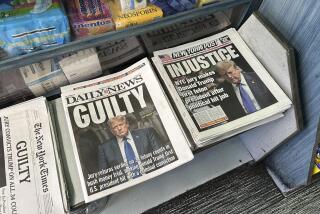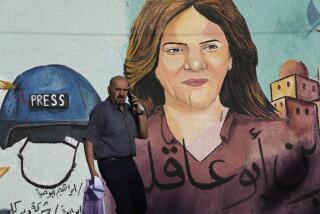The Press Spins Self-Serving Myths
- Share via
The ground war is finally heating up--no, not the one in Afghanistan, the one in the Pentagon and White House briefing rooms. The brief era of good feelings between the media and the military is already turning sour as journalists complain about being kept in the dark and off the frontlines. They take it as an article of faith that they can be trusted to inform the public without damaging the war effort.
But we need to take a closer look at the good conduct medals they claim to have won in previous wars to see whether they aren’t spinning some self-serving myths.
* Myth No. 1: U.S. journalists enjoyed unfettered access to the battlefield in World War II, during which they showed good judgment in the information they chose to reveal or conceal. In reality, many major battles in World War II were never seen, let alone covered, by the press. Of the 461 Allied reporters and photographers accredited to cover the D-Day invasion of France, only a handful went in during the initial assault. Most of the 180-strong U.S. press contingent did their reporting from the rear echelons. Even legendary war correspondent Ernie Pyle, who was assigned to Gen. Omar Bradley’s headquarters unit, didn’t arrive in Normandy until days after the landing.
Perhaps even more surprising to today’s independent-minded war correspondents, accreditation meant actually joining the military. Reporters wore uniforms, held the rank of captain and, in some cases, trained with the troops. They were also subject to the Uniform Code of Military Justice. At least in theory, this meant that they could be court-martialed and even executed for disobeying military orders.
Reporters were also accompanied everywhere by a military public affairs officer responsible for taking their copy to military censors. These censors had the power to delete a vast range of material, including reports on the effect of enemy attacks, the use of new weapons and tactics and anything “likely to injure the morale of Allied forces.” This last stipulation is the reason very few photographs of dead or wounded soldiers ever appeared in print.
Yet, as George Orwell noted, “any fair-minded person with journalistic experience will admit that during this war, official censorship has not been particularly irksome.” By and large, most U.S. reporters agreed with him. No one wanted to report anything that might jeopardize Allied operations or hurt civilian morale. Even when confronted on the battlefield with what would now be denounced as Allied atrocities, reporters kept quiet.
* Myth No. 2: American journalists won’t give away any operational matters that put our soldiers at risk. On the contrary, during the Korean War journalists disclosed so much sensitive information on military operations that they pleaded with Gen. Douglas MacArthur to impose formal military censorship to save them from themselves.
They did not want to be the judge of what might harm Allied troops, especially given the competitive pressures to be first with the story. When MacArthur finally relented, the decision received overwhelming support from journalists.
* Myth No. 3: It was the military that lied in Vietnam, but the press still gets blamed unfairly for telling unpopular truths. This is only partly true. With no censorship whatsoever, the press enjoyed unprecedented freedom to cover the conflict in Vietnam. But the Kennedy and Johnson administrations’ constant fudging of the facts in a futile effort to show progress eroded press confidence in the accuracy of military briefings.
When North Vietnam launched its Tet offensive against South Vietnam’s cities in 1968, the Saigon press corps and others quickly reported it as a catastrophe for the United States.
We now know that Tet was a disaster for the Viet Cong. In open battle with U.S. forces, they suffered severe losses and were forced to retreat. But after so many years of spin, the press refused to believe the military’s claims of victory.
Tet became a turning point in support for the war. Within a month of the media framing Tet as a disaster, a majority of Americans described themselves as doves--a plurality that was to remain unchanged for the rest of the war.
Although the government and military created the climate of mistrust, the fact remains that the press--free of the constraints of censorship--misreported the most important battle of the war and changed the direction of public opinion.
The moral is that journalists point to their performance in covering previous wars at their own peril.
Those who would impugn their patriotism or professionalism do so unfairly. But with so much at stake in this war, journalists should be wary of confusing the public’s right to know with their own right to break a story.
More to Read
Sign up for Essential California
The most important California stories and recommendations in your inbox every morning.
You may occasionally receive promotional content from the Los Angeles Times.









